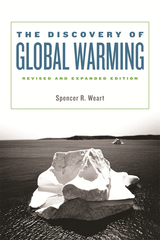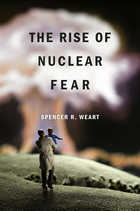
THIS EDITION HAS BEEN REPLACED BY A NEWER EDITION..
In 2001 a panel representing virtually all the world's governments and climate scientists announced that they had reached a consensus: the world was warming at a rate without precedent during at least the last ten millennia, and that warming was caused by the buildup of greenhouse gases from human activity. The consensus itself was at least a century in the making. The story of how scientists reached their conclusion--by way of unexpected twists and turns and in the face of formidable intellectual, financial, and political obstacles--is told for the first time in The Discovery of Global Warming. Spencer R. Weart lucidly explains the emerging science, introduces us to the major players, and shows us how the Earth's irreducibly complicated climate system was mirrored by the global scientific community that studied it.
Unlike familiar tales of Science Triumphant, this book portrays scientists working on bits and pieces of a topic so complex that they could never achieve full certainty--yet so important to human survival that provisional answers were essential. Weart unsparingly depicts the conflicts and mistakes, and how they sometimes led to fruitful results. His book reminds us that scientists do not work in isolation, but interact in crucial ways with the political system and with the general public. The book not only reveals the history of global warming, but also analyzes the nature of modern scientific work as it confronts the most difficult questions about the Earth's future.

The award-winning book is now revised and expanded.
In 2001 an international panel of distinguished climate scientists announced that the world was warming at a rate without precedent during at least the last ten millennia, and that warming was caused by the buildup of greenhouse gases from human activity. The story of how scientists reached that conclusion—by way of unexpected twists and turns—was the story Spencer Weart told in The Discovery of Global Warming. Now he brings his award-winning account up to date, revised throughout to reflect the latest science and with a new conclusion that shows how the scientific consensus caught fire among the general world public, and how a new understanding of the human meaning of climate change spurred individuals and governments to action.

Our thinking is inhabited by images-images of sometimes curious and overwhelming power. The mushroom cloud, weird rays that can transform the flesh, the twilight world following a nuclear war, the white city of the future, the brilliant but mad scientist who plots to destroy the world-all these images and more relate to nuclear energy, but that is not their only common bond. Decades before the first atom bomb exploded, a web of symbols with surprising linkages was fully formed in the public mind. The strange kinship of these symbols can be traced back, not only to medieval symbolism, but still deeper into experiences common to all of us.
This is a disturbing book: it shows that much of what we believe about nuclear energy is not based on facts, but on a complex tangle of imagery suffused with emotions and rooted in the distant past. Nuclear Fear is the first work to explore all the symbolism attached to nuclear bombs, and to civilian nuclear energy as well, employing the powerful tools of history as well as findings from psychology, sociology, and even anthropology. The story runs from the turn of the century to the present day, following the scientists and journalists, the filmmakers and novelists, the officials and politicians of many nations who shaped the way people think about nuclear devices. The author, a historian who also holds a Ph.D. in physics, has been able to separate genuine scientific knowledge about nuclear energy and radiation from the luxuriant mythology that obscures them. In revealing the history of nuclear imagery, Weart conveys the hopeful message that once we understand how this imagery has secretly influenced history and our own thinking, we can move on to a clearer view of the choices that confront our civilization.

After a tsunami destroyed the cooling system at Japan’s Fukushima Nuclear Power Plant, triggering a meltdown, protesters around the world challenged the use of nuclear power. Germany announced it would close its plants by 2022. Although the ills of fossil fuels are better understood than ever, the threat of climate change has never aroused the same visceral dread or swift action. Spencer Weart dissects this paradox, demonstrating that a powerful web of images surrounding nuclear energy holds us captive, allowing fear, rather than facts, to drive our thinking and public policy.
Building on his classic, Nuclear Fear, Weart follows nuclear imagery from its origins in the symbolism of medieval alchemy to its appearance in film and fiction. Long before nuclear fission was discovered, fantasies of the destroyed planet, the transforming ray, and the white city of the future took root in the popular imagination. At the turn of the twentieth century when limited facts about radioactivity became known, they produced a blurred picture upon which scientists and the public projected their hopes and fears. These fears were magnified during the Cold War, when mushroom clouds no longer needed to be imagined; they appeared on the evening news. Weart examines nuclear anxiety in sources as diverse as Alain Resnais’s film Hiroshima Mon Amour, Cormac McCarthy’s novel The Road, and the television show The Simpsons.
Recognizing how much we remain in thrall to these setpieces of the imagination, Weart hopes, will help us resist manipulation from both sides of the nuclear debate.

A small group of scientists in Paris was among the first in the world to take nuclear fission dead seriously. During one extraordinary year the team wrote a secret patent, sketched a workable device, and persuaded government and industry to underwrite their research.
The year was 1939.
The secret patent was a crude uranium bomb.
The device was a nuclear reactor.
Spencer Weart tells the astonishing story of how a few individuals at laboratory benches unleashed a power that has transformed our world. Weart's riveting account of the origins of nuclear energy--the first to be written by an author who is both physicist and historian--follows developments from Marie Curie's experiments with radium to the late 1940s when her son-in-law, Frédéric Joliot-Curie, launched France's atomic energy program, opening the age of nuclear arms proliferation. Focusing on the French work, which was often only days or even hours apart from similar breakthroughs in the United States and elsewhere, the author probes all parts of the discovery process. He covers not only the crucial steps from laboratory experiment to working reactor and bomb, but also the wider campaign of these French scientist-politicians to secure funds and materials on an unheard-of scale and to govern the outcome of their work through secrecy and patents. A rounded portrait of the French team's interaction with the rest of society, Scientists in Power reveals the close connections among laboratory breakthroughs, industrial and military interests, and the flow of politics and ideology.
The account ranges from lucid explanation of the technical challenges overcome by the scientists to suspenseful stories of escape and covert operations in World War II, such as the airlifting of hundreds of pounds of "heavy water" from Norway to France under the nose of an alerted Luftwaffe. Among the contributions of these scientists, who laid much of the groundwork for the Manhattan Project, are new perceptions about the sociology and politics of science. In short, Scientists in Power affords an outstandingly clear and readable exploration of the relations among science, society, and technology--relations at the fulcrum of modern history.
READERS
Browse our collection.
PUBLISHERS
See BiblioVault's publisher services.
STUDENT SERVICES
Files for college accessibility offices.
UChicago Accessibility Resources
home | accessibility | search | about | contact us
BiblioVault ® 2001 - 2024
The University of Chicago Press









